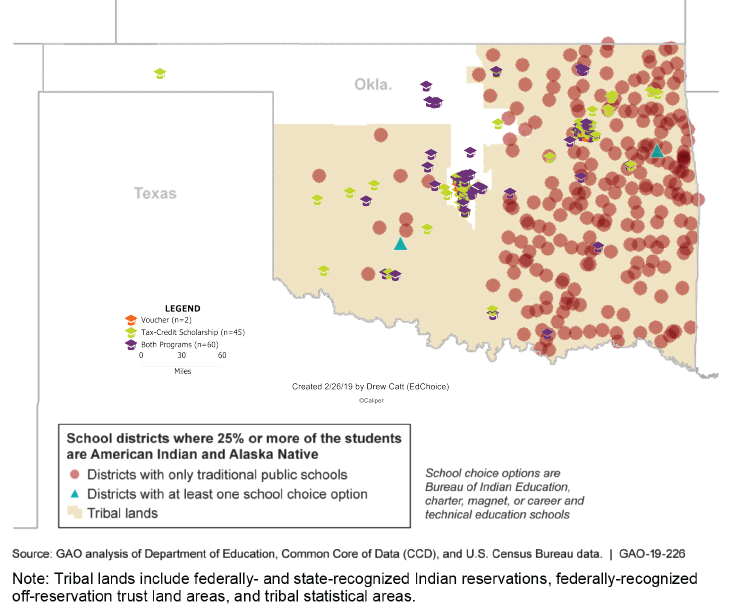New Government Report on Educational Options for American Indian Students Omits Private Schools
The Government Accountability Office (GAO) publicly released a report yesterday titled Public School Choice: Limited Options Available for Many American Indian and Alaska Native Students, which I found thoroughly fascinating. However, the GAO seems to have egregiously omitted the private school options available to those students.
As regular readers of this blog know, I’ve been making several maps focused on private schools on a state-by-state basis over the past 15 months. Luckily for all of us, the GAO report has several maps in one of the appendices. Even more of a boon: The state that appears to have the most districts mapped also happens to be one of the states where I’ve already mapped all private school locations—Oklahoma.
I realize that it wouldn’t be logical of me to assume that all students are currently able to financially access all private schools in Oklahoma (or any state for that matter…yet), so I cross-referenced the private school dataset I already created for Oklahoma with:
• the most recent list of approved schools for the Lindsey Nicole Henry Scholarships for Students with Disabilities program—the state’s voucher program for students with special needs and those in out-of-home placement or adopted out of state custody
• the lists of schools from all six scholarship-granting organizations participating in the Oklahoma Equal Opportunity Education Scholarships program—the state’s tax-credit scholarship program for students living in households with incomes up to 300 percent of the free and reduced-price lunch program ($139,305 for a family of four in 2018–19) or attending or living in the attendance zone of a public school designated by the state as “in need of improvement”
I did have to add four schools from scholarship-granting organization lists that were not in my dataset from last summer, but I had already geocoded the rest.
Here’s the result, overlaid on the Oklahoma portion of the Figure 10 map from the GAO report.
The two orange graduation caps are voucher schools. The 45 green graduation caps are tax-credit scholarship-accepting schools, and the 60 purple graduation caps are private schools participating in both school choice programs in Oklahoma. This map excludes the 65 private schools not participating in either program.

I would be remiss if I didn’t point out that not every American Indian or Alaska Native student in Oklahoma necessarily lives within a 30-minute drive of any of the above mapped voucher or tax-credit scholarship schools. (My previous drive-time analysis showed 4 percent of the state’s students live more than a 45-minute drive from a least one private school, regardless of program participation.) It’s also important to note that some of those students might not currently qualify for the state’s voucher or tax-credit scholarship programs.
However, I think it is paramount that any discussion of non-traditional options for any population of students includes private school options—especially in the case of states with private school choice programs that help more families afford them.
If you would like to pitch new mapping projects to the EdChoice research team, email research@edchoice.org.




